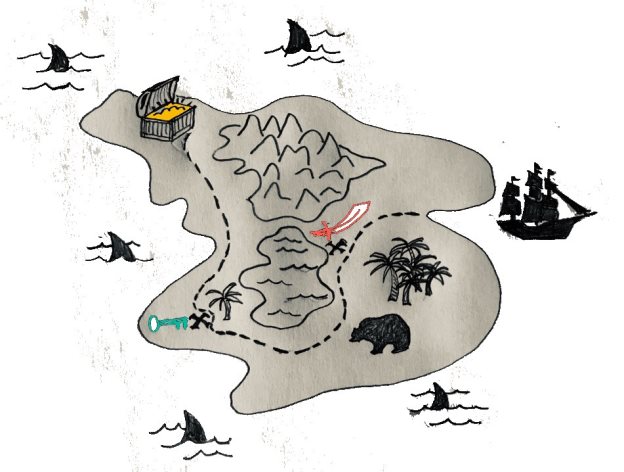Start Your Project With at Least a One-Pager
The purpose of this blog is to address those projects that start without anything. I’d like to offer a solution that is quick to create and at least gets it started with a simple one-pager. Starting the project is under the INITIATE and RATIONALIZE step in the MPM Model and the piece is the Project Charter.

Starting with high-level descriptions of project items is under INITIATE and RATIONALIZE
At Least Start With Something
Sometimes projects are started and people are assigned without even a description of the expected destination. I get it, there is no time to get bogged down in bureaucracy and producing documents. It’s too much work.
However, having a little knowledge documented about where you expect to go even for small projects, can save wasting a lot of time, resources, and money.
Even pirates had a one-pager before they set off in search of treasure.

So, at least create a 1-page charter.
What should this 1-pager have on it?
Start with a title of the name, handle, or label for your project.
Call the first section the Purpose and type out one or two sentences that includes the outcome that is expected, and how it can help whoever is on the receiving end, and then the actual benefit that provides them.
For example, “The project is providing / creating / implementing / doing x, so someone / customer / group gets y, which helps them / delivers to them the benefit / value / result of z.”
Call the second section, the Key Stakeholders, and create a three-column table to list your key stakeholders. In the first column, put their name, and maybe keep the list small, such as your top 3 to 6 stakeholders.
In the second column, put the reason for including them, their role, such as providing money, or approval, or they need to be informed for whatever reason.
No, I am not doing a RACI matrix here, just keep it simple. If you don’t know what RACI is, then ignore that last sentence. Just ask yourself, why are they involved in the first place?
In the third column, put in how you are going to keep them informed, such as by email and the frequency, or by using a pull status, or whatever delivery method is appropriate.
In the third section, we need to set expectations for Outcomes, and so call it Objectives and list how you are going to measure them when you are done and a date. This is very important because it helps you be realistic about the Purpose that you defined above.
Make sure that you can measure what you have defined, and you could give the measure to someone else to get the same result, such as a sixth grader.
If you feel inspired, also list below each Objective, the high-level deliverables that could go along with that.

You should be about halfway down your page now.
Call the fourth section Risks and here just use a statement format. Make each statement about the length of the old-style tweet (140 characters) or 30 words, and list around three of them.
For the statement format for each use: “If (the Issue occurs), then (the problem it causes), and (the impact this has).” The formula is: Issue -> Problem -> Impact.
Call the fifth section, the Financials and list how much you plan to spend and a couple dates for that spend if it is relevant. You can skip the CAPEX or OPEX discussion right now if you want, but at least put down a figure for the money, or put a range, such as +/- 50%.
There you have it, a 1-page charter. Not perfect, and not all of the detail required, but better than nothing.
Some additional sections you can add that might help as well are what is In and Out of Scope and any Assumptions.
It’s surprising how many initiatives are started without identifying the expected destination.
Think of it as going on a (purpose) quick sailing pleasure trip for a day with (key stakeholders) a few friends, they may want to know (objectives) where you are going specifically such as a destination, or time you will be out, or how far, and so that usually involves describing something that can be measured, and you all gauge (risks) if the boat and supplies can make it there and back and the necessary skill sets available and the weather is good, and the (schedule) time it is going to take, and (financials) such as people’s time and cost of supplies and materials.
Conclusion
In conclusion, start your initiative or small project with something, even if it is just a one-pager because it helps to solidify some key assumptions in your mind about where you are going and what the end-state will look like when you get there.
Obviously a more comprehensive project charter is recommended, but if you don’t feel you have time, at least do a one-pager.
Action Steps / Apply This Knowledge
- If you have started an initiative and don’t have anything documenting where you expect to go, at least start with a one-pager.
- Use the sections identified above and a couple of items underneath. Keep it to one-page if you don’t have much time.
- If you have more time create a more comprehensive charter. Go the Learning Hub at simplepmstrategies.com and follow the article on creating a charter.
- Prompt engineering guidance for AI GPTs such as chatGPT: “I’m a business leader launching a project whose purpose is Y, and delivering X. What are some things I should consider when writing a very brief charter?”
Learn More to Do More
Business evolves through change initiatives otherwise known as projects. The key to managing these change initiatives so you have more time, and less stress is to use simple strategies and tools.
Check out the Learning Hub’s other Articles with Actionable Steps, organized, with a busy leader in mind, by topic or main idea, and with some AI GPT (e.g. ChatGPT) prompt engineering suggestions under each of the Action steps: https://simplepmstrategies.com/learning-hub-index
INITIATE – Start With at Least a One-Pager
© Simple PM Strategies 2024
